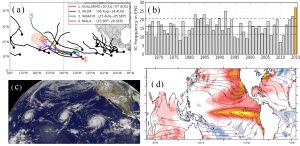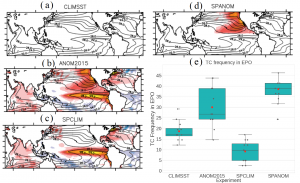Dominant Role of Subtropical Pacific Warming in Extreme Eastern Pacific Hurricane Seasons: 2015 and the Future
This is a short summary of paper Murakami et al. (2017) [1].
1. Introduction
The 2015 hurricane season in the Eastern and Central Pacific Oceans (EPO and CPO), particularly around Hawaii, was extremely active (Fig. 1a) – including a record number of tropical cyclones (TCs; Fig. 1b) and the first instance of three simultaneous Category 4 hurricanes in the EPO and CPO (Fig. 1c). A strong El Niño developed during the 2015 boreal summer season (Fig. 1d), and was attributed by some to be the cause of the extreme number of TCs.

Fig. 1: (a) Historical record of 27 tropical cyclones generated in the 2015 hurricane season; (b) Time series of TC frequency in the EPO; (c) First instance of 3 simultaneous Category 4 hurricanes (Courtesy of NASA); and (d) Sea surface temperature anomaly (SSTA) during the 2015 hurricane season (shading) and the climatological mean (contour).
2. Main Findings
Here we identify the cause of 2015 active hurricane season using a suite of targeted high-resolution model experiments. The main findings are as follows.
- The extreme 2015 EPO and CPO hurricane season was not primarily induced by the 2015 El Niño’s tropical Pacific warming, but by warming in the subtropical Pacific Ocean, the so-called “warm blob” (Fig. 2).
- The warm blob is not typical of El Niño, but rather the “Pacific Meridional Mode (PMM)” superimposed on long-term anthropogenic warming.
- The high-resolution GFDL coupled model, FLOR (Vecchi et al. 2014)[2], projects an increase in the frequency of such extremely active TC years over the next few decades for the EPO, CPO, and Hawaii due enhanced subtropical Pacific warming from anthropogenic greenhouse forcing.
- The likelihood of such an extreme year depends on the phase of natural variability, especially phase of PMM.

Fig. 2: Result of the idealized seasonal forecast prescribed by the four SST conditions. (a) Climatological mean SST (CLIMSST), (b) SST condition in 2015 (ANOM2015), (c) As in (b), except that SSTAs are set to zero north of 15°N (SPCLIM), and (d) SSTAs are set to zero everywhere except north of 15°N (SPANOM). (d) shows the simulated TC frequency in the EPO prescribed by the SST conditions, highlighting that the subtropical SSTA (SPANOM) imposes extreme number of TC genesis in the EPO, whereas the tropical SSTA (SPCLIM) suppresses TC genesis in the EPO. Adapted from Murakami et al. (2017)[3]
3. Reference
![[pdf]](http://www.bamboodream.sakura.ne.jp/hiroblog/wp-content/plugins/papercite/img/pdf.png)
[Bibtex]
@Article{MURAKAMI2016B,
author = {Hiroyuki Murakami and Gabriel A. Vecchi and Gabriele Villarini and Thomas L. Delworth and Richard Gudgel and Seth Underwood and Xiaosong Yang and Wei Zhang and Shian-Jiann Lin},
title = {Seasonal forecasts of major hurricanes and landfalling tropical cyclones using a high-resolution GFDL coupled climate model.},
year = 2016,
journal = JC,
pdf = {/hiroblog/wp-content/papercite-data/pdf_paper/Murakami_etal_2016A_JCLI.pdf},
volume = 29,
pages = {7977-7989},
doi = {10.1175/JCLI-D-16-0233.1},
}![[pdf]](http://www.bamboodream.sakura.ne.jp/hiroblog/wp-content/plugins/papercite/img/pdf.png)
[Bibtex]
@Article{VECCHI2014,
author = {G. A. Vecchi and T. Delworth and R. Gudgel and S. Kapnick and A. Rosati and A. T. Wittenberg and F. Zeng and W. Anderson and V. Balaji and K. Dixon and L. Jia and H.-S. Kim and L. Krithnamulthy and R. Msadek and W.F. Stern and S.D. Underwood and G. Villarini and X. Yand and S. Zhang},
title = {On the seasonal forecasting of regional tropical cyclone activity },
journal = JC,
volume = {27},
pages = {7994-8016},
year = {2014},
doi = {doi:10.1175/JCLI-D-14-00158.1},
pdf = {http://journals.ametsoc.org/doi/pdf/10.1175/JCLI-D-14-00158.1},
}![[pdf]](http://www.bamboodream.sakura.ne.jp/hiroblog/wp-content/plugins/papercite/img/pdf.png)
[Bibtex]
@Article{MURAKAMI2017A,
author = {H. Murakami and Gabriel A. Vecchi and Thomas L. Delworth and Andrew T. Wittenberg and Seth Underwood and Richard Gudgel and Xiaosong Yang and Liwei Jia and Fanrong Zeng and Karen Paffendorf and Wei Zhang},
title = {Dominant role of subtropical Pacific warming in extreme eastern Pacific hurricane seasons: 2015 and the future.},
year = 2017,
volume = 30,
pages = {243-264},
journal = JC,
pdf = {/hiroblog/wp-content/papercite-data/pdf_paper/Murakami_etal_2017A_JCLI.pdf},
doi = {10.1175/JCLI-D-16-0424.1},
}
